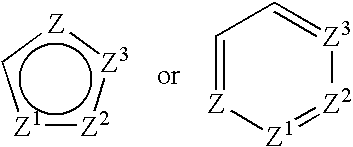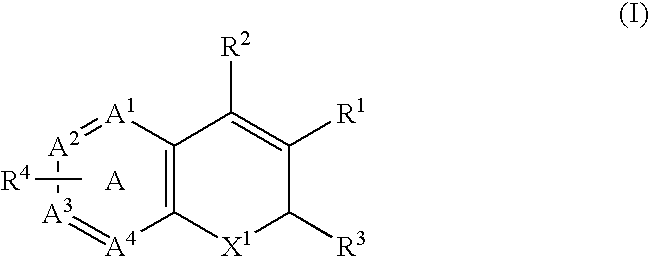Combination of a Cox-2 inhibitor and a DNA topoisomerase I inhibitor for treatment of neoplasia
a technology of dna topoisomerase and cox-2 inhibitor, which is applied in the field of combination of dna topoisomerase inhibitor and cox-2 inhibitor for the treatment of neoplasia, can solve the problems of inability to use in the treatment of tumors located in other areas, such as the backbone, and inability to treat disseminated neoplastic conditions such as leukemia, and achieves non-feasibility surgery
- Summary
- Abstract
- Description
- Claims
- Application Information
AI Technical Summary
Benefits of technology
Problems solved by technology
Method used
Image
Examples
example 1
[0913] This example shows the preparation of celecoxib.
[0914] Step 1: Preparation of 1-(4-methylphenyl)-4,4,4-trifluorobutane-1,3-dione. Following the disclosure provided in U.S. Pat. No. 5,760,068, 4′-methylacetophenone (5.26 g, 39.2 mmol) was dissolved in 25 mL of methanol under argon and 12 mL (52.5 mmol) sodium methoxide in methanol (25%) was added. The mixture was stirred for 5 minutes and 5.5 mL (46.2 mmol) ethyl trifluoroacetate was added. After refluxing for 24 hours, the mixture was cooled to room temperature and concentrated. 100 mL 10% HCl was added and the mixture extracted with 4×75 mL ethyl acetate. The extracts were dried over MgSO4, filtered and concentrated to afford 8.47 g (94%) of a brown oil which was carried on without further purification.
[0915] Step 2: Preparation of 4-[5-(4-methylphenyl)-3-(trifluoromethyl)-1H-pyrazol-1-yl]benzenesulfonamide. To the dione from Step 1 (4.14 g, 18.0 mmol) in 75 mL absolute ethanol, 4.26 g (19.0 mmol) 4-sulphonamido-phenylhydr...
example 2
[0916] This example illustrates the production of a composition containing celecoxib and a indenoisoquinoline DNA topoisomerase 1 inhibitor, such as 6-(3-carboxy-1-propyl)-5,6-dihydro-5,11-diketo-11H-indeno[1,2-c]isoquinoline, and a pharmaceutical composition containing the combination.
[0917] Following the disclosure of U.S. Pat. No. 6,509,344, 6-(3-carboxy-1-propyl)-5,6-dihydro-5,11-diketo-11H-indeno[1,2-c]isoquinoline can be prepared by the following procedure:
[0918] Step 1: Preparation of 5,6-Dihydro-6-(4-hydroxy-1-butyl)-5,11-diketo-11H-indeno[1,2-c]isoquinoline. 4-Amino-1-butanol (0.891 g, 10 mmol) was added to a chloroform (30 mL) solution of benz[d]indeno[1,2-b]pyran-5,11-dione (2.48 g, 10 mmol) and the reaction mixture was stirred at room temperature 2 days. The reaction mixture turned dark red. The reaction mixture was taken in chloroform (100 mL) and washed with water (2×50 mL), 0.5 N HCl (50 mL), brine (100 mL) and dried (Na2SO4) and concentrated to give the crude produ...
example 3
[0925] This example illustrates an animal model that can be used for in vivo analysis of the efficacy of a Cox-2 inhibitor in combination with a DNA topoisomerase I inhibitor in the treatment of neoplasia.
[0926] In vivo assessment of the effect of a pharmaceutical composition comprising a Cox-2 inhibitor and a DNA topoisomerase I inhibitor (hereafter Cox-2 / topo-I) on proliferation of certain cancer cells can be performed using a nude mouse xenograft model. Mice can be chosen from several commercially available athymic strains including BALB / c nu / nu, C57BL / 6 nulnu, NIH-III nu / nu, or any other strain of nude mouse known to one of skill in the art. Nulnu mice from 4-8 weeks of age can be injected subcutaneously in one flank with a predetermined number of tumor cells (e.g. 3×106 cells). Tumor cells used for injection can be any cancerous cell, for example, any of the several hundred cancer cell lines available from the American Type Culture Collection (Rockville, Md.), including, for e...
PUM
| Property | Measurement | Unit |
|---|---|---|
| melting point | aaaaa | aaaaa |
| size | aaaaa | aaaaa |
| diameter | aaaaa | aaaaa |
Abstract
Description
Claims
Application Information
 Login to View More
Login to View More - R&D
- Intellectual Property
- Life Sciences
- Materials
- Tech Scout
- Unparalleled Data Quality
- Higher Quality Content
- 60% Fewer Hallucinations
Browse by: Latest US Patents, China's latest patents, Technical Efficacy Thesaurus, Application Domain, Technology Topic, Popular Technical Reports.
© 2025 PatSnap. All rights reserved.Legal|Privacy policy|Modern Slavery Act Transparency Statement|Sitemap|About US| Contact US: help@patsnap.com



